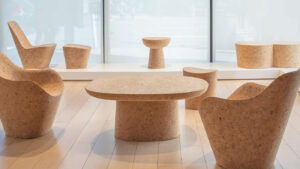As our world becomes more aware of the pressing need to address climate change and reduce our
carbon footprint, sustainability has become a buzzword in various industries. Furniture
manufacturing is no exception, with an increasing demand for environmentally friendly materials
and practices. In this blog, we’ll explore some of the most promising environmentally friendly
materials for making furniture and the benefits they offer to both consumers and the planet.
• Bamboo: Nature’s Versatile Wonder
Bamboo has gained immense popularity in recent years as an environmentally friendly material
for furniture production. This fast-growing grass can be harvested in just a few years, making it
an excellent alternative to slow-growing hardwoods. Bamboo is not only sustainable but also
incredibly durable, making it suitable for various furniture types, including chairs, tables, and
flooring.
Benefits of Bamboo:
• Rapid growth and renewability
• High tensile strength
• Low maintenance and longevity
• Aesthetic versatility

• Reclaimed Wood: Beauty in Imperfection
Reclaimed wood is another sustainable choice for furniture production. It involves using wood
salvaged from old buildings, barns, or other sources, giving new life to discarded materials. This
not only reduces the demand for fresh timber but also preserves the character and history of the
wood, creating unique and charming furniture pieces.
Benefits of Reclaimed Wood:
• Reduces deforestation and waste
• Adds character and a rustic feel to furniture
• Reduces carbon emissions associated with processing new wood
• Supports the circular economy

• Recycled Plastic: Turning Trash into Treasure
Recycled plastic has revolutionized the furniture industry by transforming plastic waste into
stylish and durable pieces. This material is incredibly versatile and can be molded into various
shapes and designs. Using recycled plastic not only diverts plastic waste from landfills but also
reduces the energy required to produce new plastic.
Benefits of Recycled Plastic:
• Reduces plastic pollution
• Requires minimal maintenance
• Resistant to moisture and weathering
• Long-lasting and durable

-
Cork: Nature’s Quiet Contribution
Cork is an eco-friendly material that comes from the bark of cork oak trees. Harvesting cork does
not harm the trees, as only the outer bark is removed, and the tree continues to grow. This
material is known for its natural insulation properties, making it an excellent choice for furniture,
especially in colder climates.
Benefits of Cork:
• Renewable and sustainable
• Insulating and energy-efficient
• Lightweight and easy to work with
• Resistant to pests and fire
As we become more conscious of the environmental impact of our choices, the furniture industry
is responding by embracing sustainable materials and practices. Bamboo, reclaimed wood,
recycled plastic, cork, and hemp are just a few examples of environmentally friendly materials
that are transforming the way we think about furniture production.
By choosing furniture made from these materials, consumers can not only enjoy stylish and
durable pieces but also contribute to the preservation of our planet’s resources and reduction of
waste. As the demand for sustainable furniture grows, it’s likely that we’ll see even more
innovative materials and designs emerge in the market, furthering our commitment to a greener
future. So, when it’s time to furnish your home, consider opting for environmentally friendly
materials – it’s a choice that benefits both you and the Earth.

-
conclusion
In conclusion, the furniture industry is responding to the pressing need for sustainability. Materials like bamboo, reclaimed wood, recycled plastic, cork, and hemp are reshaping furniture production. Choosing eco-friendly materials not only results in stylish and durable furniture but also supports the planet’s well-being. As demand for sustainability grows, expect more innovative materials and designs. Opting for green materials benefits both you and the Earth when furnishing your home.









